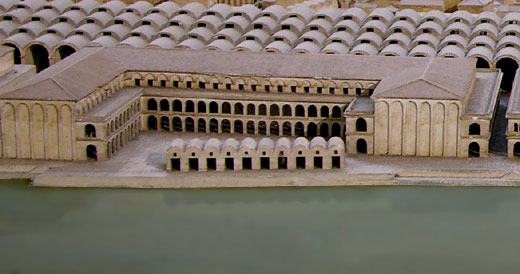
As you walk through the fence into the docks of Rome your ears are assaulted with sounds: grunts of porters carrying heavy loads (and curses when they occasionally drop them), shouts of overseers directing the unloading, scraping and rasping of ships' wooden timbers and metal fittings against the stone moorings. You hardly know how to distinguish all the smells--fish, grain, olive oil, wine, spices--and you have rarely seen so much activity. As you watch, you realize that this apparent chaos is actually highly organized; everyone knows his task and carries it out with reasonable efficiency.
This district, on the south bank of the Tiber, is popularly called the Emporium; it is the major area for the offloading of foreign goods intended for the city of Rome, although there are some other harbor areas along the Tiber (see more on this map). You go to the edge of the quay. There is a drop of 18 feet to the Tiber, and you feel dizzy as you look down at the muddy yellow river below you. The entire area is paved with stone. Ships tie up to the large mooring rings, some shaped in the form of lions' heads, and there are ramps and stairs along which cargoes are unloaded.
Because the Tiber is too shallow for the large merchant ships (up to 180 feet long and with cargoes of over 1,000 tons) that bring goods from foreign ports, these ships have to dock near the mouth of the Tiber and transfer their cargoes to smaller riverboats; this mosaic shows the process, as a porter carries goods from an ocean vessel to a riverboat. Ostia, the port directly on the mouth of the Tiber, does not afford the large ships much protection, making docking and offloading difficult, so the emperor Claudius created an artificial harbor north of Ostia, the Port of Claudius, known as Portus, with a canal cutting across to the Tiber; his successor, Nero, proudly displays it on this coin. Even this was insufficient, so Trajan dug inland from the harbor to create a very sheltered hexagonal basin. Due to the considerable skill of her engineers, therefore, Rome now has a safe and convenient seaside port.
Riverboats all have a shallow draft; some of the smaller types have oars (though the rowing is against the current), but all the larger riverboats with heavy cargo are towed up the Tiber by manpower, not animals. The journey (15 miles on a straight line) takes approximately 3 days. The most common type of large riverboat is a navis codicaria, with a single mast set in the very front of the boat to which tow ropes can be fastened.